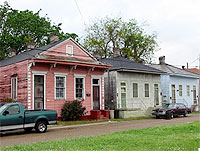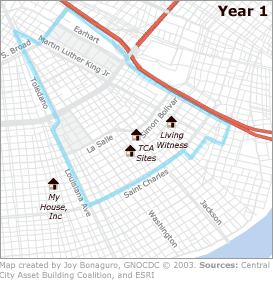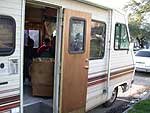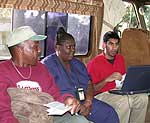![]()
Home ![]() Pre Katrina Home
Pre Katrina Home ![]() Articles
Articles ![]() Tax Refunds for the Working Poor
Tax Refunds for the Working Poor
 Tax
refunds for the working poor
Tax
refunds for the working poor
Information paves the way in New
Orleans' Central City neighborhood
Learn how
simple market research, client surveys and a keen awareness of neighborhood
geography made this free tax assistance initiative a quantifiable success.
![]()
| by Neill Goslin, Allison Plyer, & Denice Warren |
 © GNO Community Data Center A
row of double shotgun houses in New Orleans' Central City
|
Apr. 15, 2003 | Back in the 1830s, an area of New Orleans began to be developed to accommodate workers and servants for the nearby mansion-filled Garden District. This area, now called Central City, was filled with simple, shotgun-style houses built by contractors and set very close together.
At first it was home to German immigrants, and later Irish, then Italian, and then Jewish immigrants. By the turn of the century, the neighborhood was becoming racially integrated. Many of New Orleans’ most famous jazz musicians were born and raised in Central City.
A thriving business district developed along Dryades Street (now Oretha Castle Haley Blvd) in the 1930s and 40s. It was known throughout the city for unique shopping opportunities, and was one of the few areas where African Americans could shop without fear of harassment.
Resident African American doctors, lawyers and business people served this close-knit community and several were instrumental in the civil rights movement of the 1950s and 60s.
|
Want information on New Orleans neighborhoods? At the Community Data Center web site (www.gnocdc.org), you can find lots more information on all 73 neighborhoods in the City of New Orleans. For the purposes of the EITC initiative described in this article, the area of "Central City" includes the adjoining "BW Cooper Apts." Read snapshots of the history and culture of Central City and BW Cooper Apts and also view data on these neighborhoods, including demographics, income, transportation and more! |
But white flight and the departure of middle-income manufacturing jobs brought economic hardship to this once thriving working-class neighborhood. According to the 2000 Census, only 36% of adults in Central City have full-time employment. Of the residents who work, 43% have (likely low-wage) jobs in hotel, restaurant, health care and retail businesses. More than 53% of the residents live in poverty, 59% of the households have no vehicle, and 86% are renters.
Still, residents are committed to their neighborhood and are working hard to develop it through multiple initiatives. More than half of the community members have lived in the neighborhood for more than five years, and one-third have lived there for more than ten (Census 2000). Among the nonprofit initiatives that have opened up on Oretha Castle Haley Blvd in recent years are the Ashé Cultural Arts Center and Café Reconcile.
Making work pay in Central City...
Neighborhoods like Central City are places where the Earned Income Tax Credit (EITC) can make a huge difference. EITC boosts the incomes of working, low-income families by giving them an average of 1,700 additional dollars back on their taxes. Research suggests that EITC has been successful in moving families out of poverty, encouraging single mothers to work, reducing income inequality, and helping families build assets and pay bills (1, 2).
When you drive around the Central City area during tax season, you notice that commercial tax preparers have sprouted up like weeds along the business corridors, offering “refund anticipation loans” and “quick and easy tax preparation.” Often, the tax preparers are next door, or even sharing space with, check cashing centers, where many residents handle their finances given the scarcity of banks in the neighborhood.
| Tax preparation companies, check-cashing centers, and banks in the Central City vicinity | |||||||||||||||
|
|
Note that an interstate highway separates Central City from the banks in the business district. |
||||||||||||||
 Photoillustration © GNOCDC A sign advertising
commercial tax preparation in Central City
|
These companies charge high fees for tax preparation, electronic filing and refund anticipation loans. Nationwide, an estimated $1.75 billion in EITC was diverted to companies in 1999 for tax preparation, electronic filing and refund anticipation loans (2).
Here in New Orleans, more than one third of all taxpayers earned EITC refunds in tax year 2000, and nearly 60% of these EITC earners used expensive refund anticipation loans! It is likely that many other workers weren’t even aware that they were eligible for this tax credit (2).
Central City Asset Building Coalition…
|
More about the Central City Asset Building Coalition The Central City Asset-Building Coalition (CCABC) is a community based group of non-profit, government, business, financial institutions and faith-based organizations that have joined together in an effort to increase economic opportunities for residents in the Central City area. The effort has been spearheaded by the IRS, Tulane & Xavier Universities' National Center for the Urban Community (NCUC), and Living Witness Community Social Services. Agenda for Children is the Coalition’s fiscal agent and the Annie E. Casey Foundation, through the Learning Partners/Making Connections Initiatives, is the primary sponsoring agency. NCUC's university partnerships (and especially the connection to Tulane’s A.B. Freeman School of Business) provides the majority of the volunteer labor force needed to sustain the EITC initiative. |
The Central City Asset Building Coalition, a Making Connections New Orleans initiative, provides free tax assistance to help Central City residents keep more of the money they earn.
And, because tax refunds from EITC can be an ideal opportunity for families to begin working toward financial independence (3), the Coalition also links EITC taxpayers to low-cost savings accounts, individual development accounts (IDAs), credit counseling, financial literacy and homebuying educational opportunities.
Planning for Year 1
In summer 2001, Coalition members conducted a survey to help them choose the initial sites for their free tax assistance program. They learned that:
- program sites need to offer evening hours,
- sites need to be close to bus or streetcar lines, or within walking distance, and
- residents are hesitant to come to their own church to get their taxes done.
The Coalition also knew that the tax preparers would need facilities with access to computers. With these criteria in mind, they chose to start with Living Witness and My House, Inc. in the first year. These sites were a great start. Still in the back of their minds, Coalition partners knew they'd want to get more complete geographic coverage of Central City for Year 2.
| Volunteer income tax assistance sites in Central City in Year 1 | |||||||||||||
 |
|
||||||||||||
Success!
At these two initial sites, volunteers with the Central City Asset Building Coalition prepared 249 tax returns, for a total of $394, 882 in refunds! They estimated that through their services, $25,000 that would have gone to commercial tax preparers stayed in the pockets of Central City taxpayers.
A survey revealed that more than half of that year's clients learned about the initiative from a friend or family member. It was clear that generating visibility and word of mouth would be key in getting more people to the free tax service. And, from IRS data, it was also clear that many people in the area were still paying expensive fees to commercial tax preparers or weren't filing tax returns at all.
The Coalition used evidence of their success, and data suggesting a larger need in the community for their tax assistance services, to secure additional funding to expand their efforts in Year 2.
Planning for Year 2
The Coalition increased their coverage of the neighborhood by choosing a third site at the top of Central City (at the NFL Youth Education Town). And then they got real creative... and filled in gaps with the EITC Express Winnebago.
If you want to see the whole tax/financial picture for this neighborhood together (commercial and free tax sites, banks and check-cashing centers), view this pop-up map.
The EITC Express Winnebago...
Neill Goslin, Program Manager from the National Center for Urban Community, describes how the Winnebago came to be:
“There were some slow times during our first EITC campaign and many of the volunteers and myself grew tired of waiting on the taxpayers to come to us and I kept thinking, 'why couldn’t we go to them?' At some point I remembered that Women With A Vision, a group of public health education outreach specialists who also focused their efforts on Central City, had a Winnebago. With a quick phone call we had sketched out an arrangement to partner up. I’ve known these women for a long time and was confident that they would make excellent escorts into the neighborhood, and would help us raise awareness about the EITC and our free tax service.
I had forgotten how big the Winnebago was and that it was actually equipped with an examination table in the rear cabin. It made for an interesting place to set up the computer and printing station, but all the taxpayers got to see was the plush interior (a couch, a kitchenette booth, and a couple of chairs) that was big enough to accommodate about 9 people comfortably.”
 Photos courtesy of NCUC |
The EITC Express Winnebago parked outside the CJ Peete ('Magnolia') public housing development. |
 |
Volunteer Tulane student Vinny Pittapaldi (r) prepares a tax return for a neighborhood resident, while outreach worker Larry Hurst (l) looks on. |
Bigger success in Year 2...
With final results of the 2003 campaign just in, it's clear that the Coalition's strategy of getting the word out and increasing coverage in the neighborhood worked.
| Program outcomes for first two years | ||
|
Year 1
(2002) |
Year 2*
(2003) |
|
| Total number of returns filed |
249
|
530
|
| Total money in refunds |
$394,882
|
$954,000
|
| Estimated money saved for tax preparation |
$25,000
|
$53,000
|
|
Source: Central
City Asset Building Coalition, Apr
14, 2003
*estimates for 2003 |
||
Numbers like these demonstrate the economic impact of leveraging the neighborhood's assets on behalf of the residents. And, with the Central City Asset Building Coalition's commitment to using information to improve their services, next year is bound to be an even larger success.
|
Learn more about using data & information |
|
|
Numbers
talk... and at the neighborhood level they may talk
even louder! Tips
for analyzing data |
|
|
What data do funders want to see in Problem Statements? Tips for presenting data in a proposal |
|
|
Democratizing Data Steps to making the power of data work for your local community |
|
Learn more...
...about planning with data...
Good information from the start helps guarantee program success.
If you're working with a neighborhood-based organization, begin your program design with some data about the neighborhood and its residents. Only three clicks from the home page (www.gnocdc.org), you'll see data relevant to your neighborhood!
...about EITC...
Learn more about the EITC from Annie E. Casey's new web site for their National Tax Assistance for Working Families Campaign. The address is www.eitc.info. And, you'll find specific information about the Central City Asset Building Coalition's work at www.eitc.info/locations/new_orleans/.
Citations
(1) Who Knows
about the Earned Income Tax Credit? from the Urban Institute (2001)
newfederalism.urban.org/html/series_b/b27/b27.html
(2) Rewarding
Work Through the Tax Code: The Power and Potential of the Earned Income
Tax Credit in 27 Cities and Rural Areas from the Brookings Institute
(2003)
www.brookings.edu/es/urban/publications/berubetaxcode.htm
(3) The
EITC: Expectation, Knowledge, Use, and Economic and Social Mobility
from the Center for Policy Research (1999, 2000)
www-cpr.maxwell.syr.edu/cprwps/wps13abs.htm
![]()
This article is a collaboration between the Greater New Orleans Community Data Center (GNOCDC) and Making Connections New Orleans, through Tulane/Xavier's National Center for Urban Community (NCUC).The author Neill Goslin is a Program Manager with NCUC; Allison Plyer is a Senior Consultant, and Denice Warren is the Information Systems Designer at GNOCDC. Maps created by Joy Bonaguro, GNOCDC's Web and Data Production Coordinator.
Home ![]() Pre Katrina Home
Pre Katrina Home ![]() Articles
Articles ![]() Tax Refunds for the Working Poor
Tax Refunds for the Working Poor
![]()
|
Greater New Orleans Community Data Center
Last modified: April 14, 2003 |



